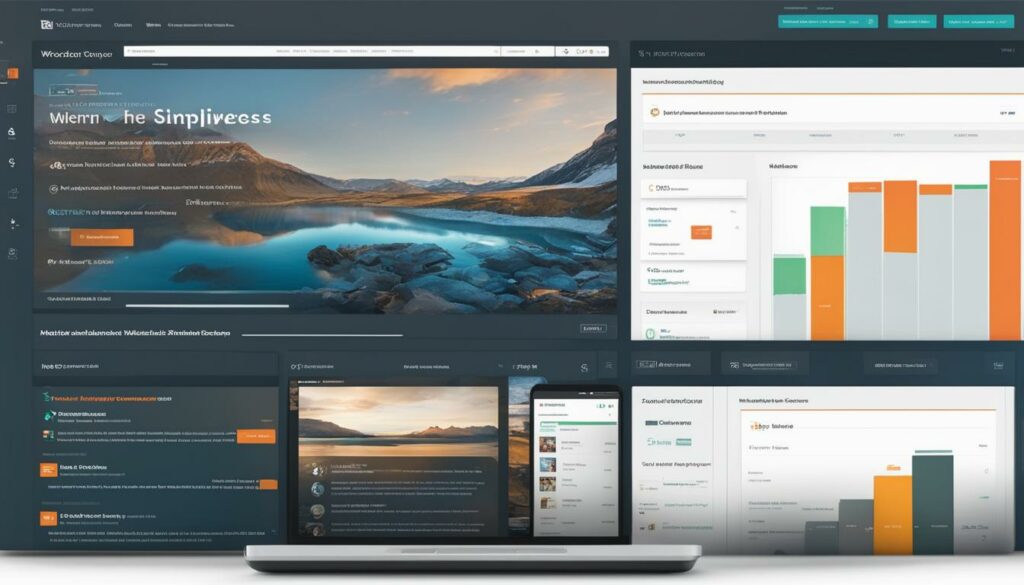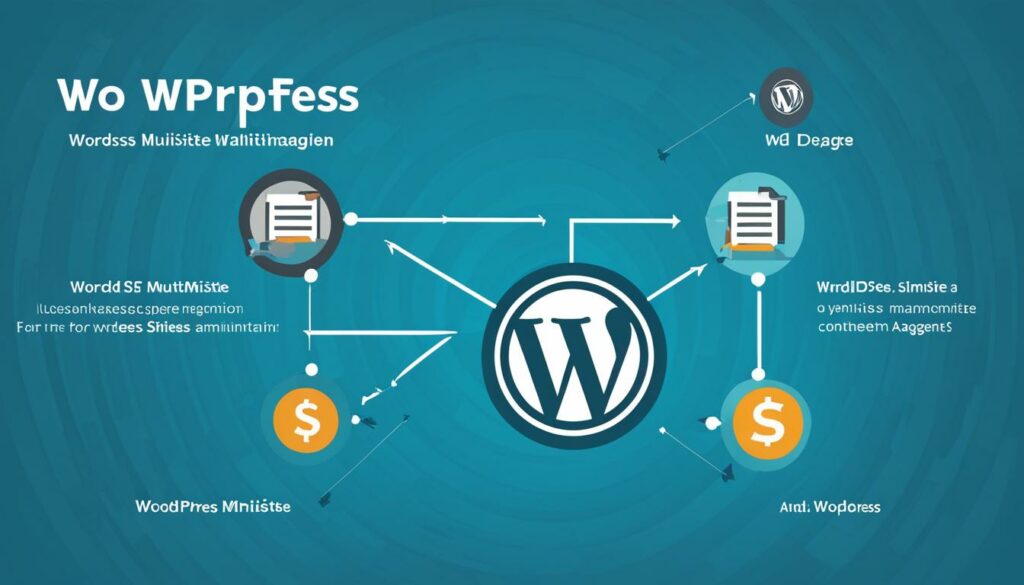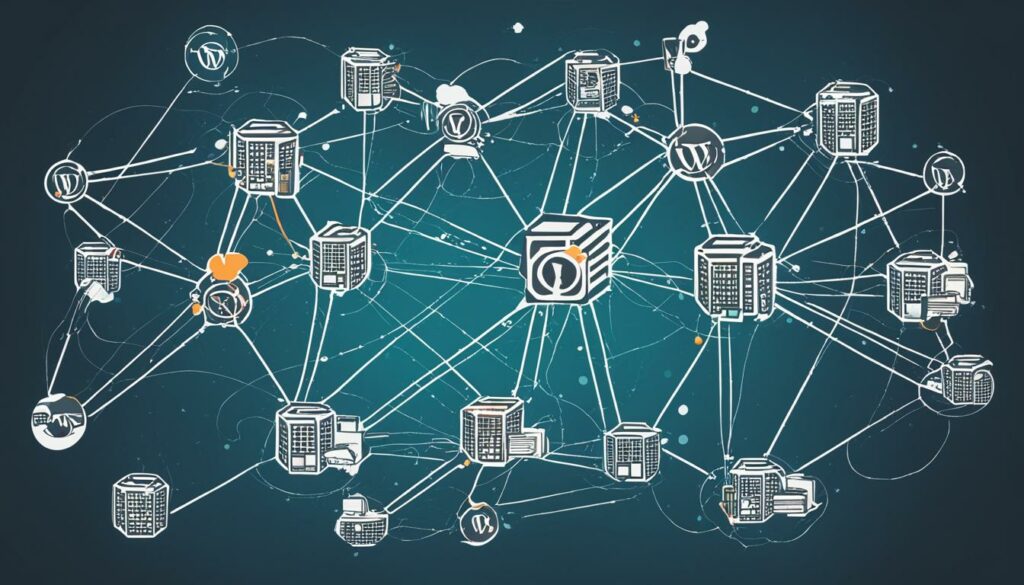Welcome to our WordPress Backup Guide! In this guide, we will explore the best practices for optimizing your WordPress Multisite administration. As you may already know, WordPress Multisite is a powerful feature that allows you to create and manage multiple websites from a single dashboard. It offers several benefits, including cost savings, simplified site management, and consistent branding across all your websites.
However, it is crucial to have a reliable backup strategy in place to protect your WordPress Multisite. In this guide, we will cover everything you need to know about backing up your WordPress websites, including the importance of backups, different backup methods, recommended backup plugins, and step-by-step tutorials on how to backup and restore your WordPress Multisite.
Whether you are new to WordPress Multisite or looking to optimize your existing setup, this guide is designed to provide you with the essential knowledge and practical tips you need to ensure the security and integrity of your WordPress Multisite.
Key Takeaways:
- Implementing a backup strategy is crucial for protecting your WordPress Multisite.
- There are multiple backup methods available, including manual backups, automated backups, and remote backups.
- Using a reliable backup plugin can simplify the backup and restore process.
- Regularly test your backup files to ensure they are working correctly.
- Stay updated with the latest backup techniques and best practices.
What is WordPress Multisite?
WordPress Multisite is a powerful feature that allows you to create and manage multiple WordPress websites from a single dashboard. It is widely used by organizations such as universities, large corporations, news and media companies, and e-commerce websites. With WordPress Multisite, you can easily create a network of websites, each with its own domain or subdomain.
As the network administrator, you have full control over the entire network. You can effortlessly add new websites, manage existing websites, and control user access and permissions. This centralized approach simplifies website management and reduces the time and effort required to maintain multiple websites.
Whether you want to create a series of blogs, departmental websites, or a network of e-commerce stores, WordPress Multisite provides the flexibility and scalability you need. It allows you to leverage the power of a single dashboard to streamline your workflow and ensure consistency across all your websites.
With WordPress Multisite, you can take advantage of the following benefits:
- Manage multiple WordPress websites: Instead of logging into individual websites, you can manage everything from a single dashboard.
- Save time and effort: With centralized administration, you can update themes, plugins, and settings across all your websites in one go.
- Control user access: As the network administrator, you have complete control over user permissions and can assign roles for each website.
- Enhanced branding: Each website can have its own domain or subdomain, allowing you to maintain consistent branding while catering to specific target audiences.
“WordPress Multisite is an efficient solution for managing multiple websites with ease. It simplifies the administration process by providing a single dashboard to handle all tasks.”
Centralized Dashboard and Network Administrator
WordPress Multisite revolves around a central dashboard that acts as the control center for all your websites. From this dashboard, you can manage themes, install plugins, add new websites, and monitor user activity. The network administrator has full control over the entire network and can easily handle any updates, changes, or security measures.
Subdomain and Domain
WordPress Multisite allows you to create websites using two different approaches: subdomains and domains. With subdomains, each website within your network will have a unique URL, such as subdomain.yourdomain.com. On the other hand, you can assign a separate domain to each website, giving them their own individual online presence. This flexibility ensures that each website caters to its target audience and maintains its unique identity.
Key Features of WordPress Multisite
WordPress Multisite offers a variety of key features that make it a valuable tool for managing multiple websites from a single installation. These features provide numerous benefits for website administrators, including cost-effectiveness, consistent branding, simplified user management, and enhanced security.
Single Installation
With WordPress Multisite, you can manage multiple websites from a single installation. This eliminates the need to install and update WordPress separately for each website, saving you time and effort.
Cost-Effective
Hosting multiple websites on a shared server reduces hosting costs compared to maintaining separate hosting accounts for each site. WordPress Multisite allows you to consolidate your websites, resulting in significant cost savings.
Consistent Branding
WordPress Multisite enables you to maintain consistent branding across all your websites. You can easily apply the same themes, plugins, and configurations to ensure a cohesive brand experience for your visitors.
Security Updates
As a network administrator, you have the ability to apply security updates across all websites in your WordPress Multisite installation. This simplifies the task of keeping all your websites secure and protected from potential vulnerabilities.
Simplified User Management
WordPress Multisite streamlines user management by allowing you to control user access and permissions from a centralized dashboard. You can add, remove, or modify user roles and permissions for multiple websites simultaneously, saving you time and effort.
Shared Server
By hosting your WordPress Multisite installation on a shared server, you can take advantage of shared resources and reduce hosting costs. This is particularly beneficial for organizations with a limited budget.
Centralized Dashboard
The centralized dashboard provided by WordPress Multisite gives you complete control over all your websites. From the dashboard, you can easily manage website settings, update plugins and themes, and monitor the performance of your websites.
| Key Features | Benefits |
|---|---|
| Single Installation | Saves time and effort in managing multiple websites |
| Cost-Effective | Reduces hosting costs by sharing resources |
| Consistent Branding | Ensures a cohesive brand experience for visitors |
| Security Updates | Simplifies the task of keeping all websites secure |
| Simplified User Management | Saves time and effort in managing user roles and permissions |
| Shared Server | Reduces hosting costs for organizations with a limited budget |
| Centralized Dashboard | Provides complete control over all websites from a single dashboard |
Best Practices for WordPress Multisite Administration
To optimize your WordPress Multisite administration, follow these best practices:
- Use a Centralized Dashboard: Manage all your websites from a centralized dashboard. This allows you to easily access and control each site without the need to log in separately.
- Standardize Plugins and Themes: Maintain consistency across your websites by using standardized plugins and themes. This ensures a cohesive user experience and simplifies maintenance and updates.
- Automate Tasks: Automate routine tasks such as backups and updates. This saves time and reduces the risk of human error, ensuring that your websites are always up-to-date and secure.
- Implement Version Control: Use version control to manage changes across your websites. This allows you to track modifications, roll back to previous versions if needed, and collaborate with team members effectively.
- Utilize a Content Management System: Streamline content creation and management with a content management system. This enables efficient publishing, editing, and organization of content across multiple websites.
- Monitor Site Analytics: Regularly monitor site analytics to gain insights into visitor behavior, traffic sources, and engagement metrics. This data can inform your decision-making and help you improve the performance of your websites.
- Create a Backup Strategy: Develop a backup strategy for all your websites. Regularly back up your files and databases to protect against data loss or website crashes. Store backups in a secure location.
- Use a Staging Environment: Set up a staging environment for testing updates and changes before implementing them on your live websites. This minimizes the risk of disrupting site functionality or user experience.
- Monitor Site Performance: Use monitoring tools to track site performance and identify areas for improvement. Optimize loading speeds, optimize images, and utilize caching to enhance user experience and SEO rankings.
- Implement Security Best Practices: Safeguard your websites by following security best practices. Use strong, unique passwords, regularly update themes and plugins, enable two-factor authentication, and implement other security measures to protect against potential threats.
Comparison of WordPress Multisite Best Practices
| Best Practices | Benefits |
|---|---|
| Use a Centralized Dashboard | Efficient management of multiple websites from a single location |
| Standardize Plugins and Themes | Consistent user experience and simplified maintenance |
| Automate Tasks | Time-saving, reduced risk of errors, and up-to-date websites |
| Implement Version Control | Effective change management and collaboration |
| Utilize a Content Management System | Efficient content creation and organization |
| Monitor Site Analytics | Insights to improve website performance |
| Create a Backup Strategy | Data protection against loss and crashes |
| Use a Staging Environment | Safe testing before implementing changes |
| Monitor Site Performance | Optimized loading speed and user experience |
| Implement Security Best Practices | Protection against potential threats |
By following these best practices, you can efficiently manage your WordPress Multisite and ensure the optimal performance and security of your websites.

WordPress Multisite Applications
WordPress Multisite offers a diverse range of applications, making it a versatile solution for various organizations and individuals. Here are some key sectors that utilize the power of WordPress Multisite:
1. Corporate Websites
Large organizations can leverage WordPress Multisite to efficiently manage multiple websites from a centralized dashboard. With consistent branding and content management, corporate websites can maintain a unified online presence.
2. Educational Institutions
WordPress Multisite is an excellent choice for educational institutions to manage their departmental websites and student blogs. It simplifies website administration while allowing for personalized content creation.
3. News and Media Organizations
News portals, online magazines, and media organizations can benefit from WordPress Multisite’s ability to manage multiple websites. It enables efficient content publishing, categorization, and management across various news categories and blogs.
4. E-commerce Websites
Using WordPress Multisite, e-commerce businesses can manage multiple websites from a single installation. This streamlines product management, inventory control, and payment processing, making it ideal for businesses with various product lines or regional-specific online stores.
5. Community Networks
WordPress Multisite can serve as a platform to build community networks, enabling users to create their own sites or profiles within the network. Examples include social networking platforms, niche community forums, or collaborative content creation platforms.
6. Membership Websites
Membership-based organizations can utilize WordPress Multisite to provide a dedicated website for each member or group within the community. This ensures secure access, personalized content, and tailored experiences for each member.
7. Personal Websites
Individuals who manage multiple websites for personal or professional purposes can consolidate their online presence using WordPress Multisite. It simplifies website management, code sharing, and maintenance tasks for improved efficiency.
These are just a few examples of the wide-ranging applications for WordPress Multisite. By leveraging its scalability and centralized management capabilities, organizations and individuals can streamline their website administration and achieve their unique goals.
Benefits and Limitations of WordPress Multisite
WordPress Multisite offers several benefits that make it an attractive option for managing multiple websites. However, there are also limitations to consider before implementing this feature.
Benefits of WordPress Multisite
- Centralized Management: With WordPress Multisite, you can easily manage all your websites from a single dashboard, saving time and effort.
- Easy Replication of Functionalities: You can replicate themes, plugins, and settings across multiple websites, ensuring consistency and saving resources.
- Cost-Effectiveness: Hosting multiple websites on a single WordPress installation can be more cost-effective compared to managing individual installations.
- Simplified User Management: WordPress Multisite allows you to manage user roles and permissions across all websites from a centralized location, streamlining user management.
Limitations of WordPress Multisite
- Shared Database: All websites in a WordPress Multisite share the same database. If one website goes down or encounters an issue, it can affect the performance of all other websites in the network.
- Plugin Compatibility: Some plugins may not be compatible with WordPress Multisite or may have limited functionality when used within a multisite network. It is important to check plugin compatibility before installation.
- Limited Hosting Support: Not all hosting providers offer support for WordPress Multisite. Before deciding to use Multisite, ensure that your hosting provider is compatible and able to handle the increased demands of managing multiple websites.
| Benefits | Limitations |
|---|---|
| Centralized Management | Shared Database |
| Easy Replication of Functionalities | Plugin Compatibility |
| Cost-Effectiveness | Limited Hosting Support |
| Simplified User Management |

Requirements to Start a WordPress Multisite
To start a WordPress Multisite, there are a few essential requirements you need to fulfill. These include:
- A hosting provider that supports multiple websites in a single hosting plan. Make sure to choose a reliable hosting provider that offers the necessary resources and scalability for your Multisite.
- WordPress installed on your hosting account. Ensure that you have the latest version of WordPress up and running.
- FTP access to your hosting account. This will allow you to modify the necessary code for subdomain and directory functionality within your Multisite.
- Plugins that enhance WordPress Multisite management. Consider using security plugins to protect your websites, performance plugins to optimize site speed, and SEO plugins to improve search engine visibility.
By meeting these requirements, you’ll be well-equipped to start and manage your WordPress Multisite effectively.

Step-by-Step Guide to Starting a WordPress Multisite
Starting a WordPress Multisite is a straightforward process that involves a few key steps. By following this step-by-step guide, you’ll be able to set up and optimize your WordPress Multisite efficiently.
- Select a Hosting Provider: Choose a hosting provider that supports multiple websites in a single hosting plan. This will ensure that your Multisite network can run smoothly and efficiently.
- Install WordPress: If you haven’t already installed WordPress, now is the time to do so. WordPress provides a user-friendly interface and extensive customization options for your Multisite network.
- Obtain FTP Access: To modify the code for subdomain and directory functionality, you’ll need FTP access. This will allow you to make the necessary adjustments to create and manage your Multisite network effectively.
- Set Up Subdomain or Directory Structure: Decide whether you want to organize your Multisite network with subdomains or directories. Subdomains allow you to have separate websites with unique URLs, while directories create websites within a parent domain.
- Modify wp-config.php File: Open the wp-config.php file and add the required code to enable Multisite functionality. This will allow WordPress to recognize and manage the multiple websites in your network.
- Update .htaccess File: Navigate to the .htaccess file and add the necessary code to redirect traffic correctly within your Multisite network. This step ensures that visitors will be directed to the appropriate website based on their chosen subdomain or directory.
- Access the Network Dashboard: Log in to your WordPress dashboard and navigate to the ‘My Sites’ section. Here, you’ll find the Network Dashboard, which allows you to manage all your websites within the Multisite network.
- Install and Activate Plugins: Enhance the functionality and management of your Multisite network by installing and activating relevant plugins. Look for plugins that specialize in security, performance, and SEO to optimize each website within your network.
By following these steps, you’ll successfully set up a WordPress Multisite network. Remember to choose a reliable hosting provider, have FTP access for code modification, and utilize plugins to enhance the management of your network. Enjoy the benefits of having multiple websites under one centralized dashboard!
Example Code for wp-config.php
/* Multisite */
define( ‘WP_ALLOW_MULTISITE’, true );
define(‘MULTISITE’, true);
define(‘SUBDOMAIN_INSTALL’, false);
define(‘DOMAIN_CURRENT_SITE’, ‘your-domain.com’);
define(‘PATH_CURRENT_SITE’, ‘/’);
define(‘SITE_ID_CURRENT_SITE’, 1);
define(‘BLOG_ID_CURRENT_SITE’, 1);
Example Code for .htaccess File
RewriteEngine On
RewriteBase /
RewriteRule ^index\.php$ – [L]# add a trailing slash to /wp-admin
RewriteRule ^([_0-9a-zA-Z-]+/)?wp-admin$ $1wp-admin/ [R=301,L]RewriteCond %{REQUEST_FILENAME} -f [OR]
RewriteCond %{REQUEST_FILENAME} -d
RewriteRule ^ – [L]
RewriteRule ^([_0-9a-zA-Z-]+/)?(wp-(content|admin|includes).*) $2 [L]
RewriteRule ^([_0-9a-zA-Z-]+/)?(.*\.php)$ $2 [L]
RewriteRule . index.php [L]
Conclusion
WordPress Multisite is a powerful feature that allows you to manage multiple websites from a single dashboard. By optimizing your WordPress Multisite administration and following best practices, you can streamline your website management process and ensure efficiency.
To optimize your WordPress Multisite, it is essential to standardize plugins and themes, automate tasks, use version control, and implement security measures. These practices will help you maintain consistency, save time, and enhance the security of your websites.
However, if you need assistance with setting up and optimizing your WordPress Multisite, consider seeking professional WordPress development services. Companies like ColorWhistle offer tailored solutions to meet your specific business needs and make the most out of WordPress Multisite. Don’t miss out on the transformative impact of WordPress solutions for your website management. Contact ColorWhistle at +1 (210) 787-3600 for more information.
FAQ
Q: What is WordPress Multisite?
A: WordPress Multisite is a feature that allows you to create and manage multiple WordPress websites from a single dashboard. It is commonly used by organizations such as universities, large corporations, news and media companies, and e-commerce websites. With WordPress Multisite, you can create a network of websites, each with its own domain or subdomain. The network administrator has control over the entire network and can easily add new websites, manage existing websites, and control user access and permissions.
Q: What are the key features of WordPress Multisite?
A: Some key features of WordPress Multisite include running a network of websites from a single WordPress installation, creating a network of directories or subdomains, easily replicating functionalities across websites, and having control as the Super Admin. It allows you to customize the branding of each website, apply security updates across all websites, and simplify user management. WordPress Multisite can be hosted on a shared server, reducing hosting costs. It also provides a centralized dashboard for managing all your WordPress websites.
Q: What are the best practices for WordPress Multisite administration?
A: To optimize your WordPress Multisite administration, it is recommended to use a centralized dashboard to manage all your websites, standardize plugins and themes for consistency, automate routine tasks such as backups and updates, use version control to manage changes, use a content management system to streamline content creation and management, monitor site analytics for trends and improvements, create a backup strategy for all your websites, use a staging environment for testing updates, monitor site performance with monitoring tools, and implement security best practices such as strong passwords, regular updates, and two-factor authentication.
Q: What are the applications of WordPress Multisite?
A: WordPress Multisite has a wide range of applications. It is commonly used by large organizations to manage their various websites from a single dashboard, ensuring consistency in branding and content. Educational institutions use WordPress Multisite for managing departmental websites and student blogs. News and media organizations use it to manage multiple websites such as news portals and blogs. E-commerce websites can benefit from managing multiple websites from a single installation, and community networks and membership websites can create and manage user-generated sites or profiles. Even personal websites can be migrated to a Multisite installation for easier management and code sharing.
Q: What are the benefits and limitations of WordPress Multisite?
A: Some benefits of using WordPress Multisite include centralized management, easy replication of functionalities, cost-effectiveness, and simplified user management. However, there are also limitations to consider, such as the fact that all websites share the same database, so if one website goes down, all websites are affected. Additionally, some plugins may not support WordPress Multisite, and not all hosting providers offer support for it. It is important to weigh the pros and cons before deciding if WordPress Multisite is the right choice for your needs.
Q: What are the requirements to start a WordPress Multisite?
A: To start a WordPress Multisite, you will need a hosting provider that supports multiple websites in a single hosting plan. You will also need to have WordPress installed and FTP access to modify the code for subdomain and directory functionality. It is also recommended to use plugins that enhance WordPress Multisite management, such as security, performance, and SEO plugins.
Q: What is the step-by-step guide to starting a WordPress Multisite?
A: The step-by-step guide to starting a WordPress Multisite includes selecting a hosting provider that supports multiple websites, installing WordPress if not already installed, and obtaining FTP access to modify the code for subdomain and directory functionality. It is also recommended to use plugins that enhance WordPress Multisite management, such as security, performance, and SEO plugins. Following these steps will help you set up and optimize your WordPress Multisite.
Q: How can I optimize my WordPress Multisite administration?
A: WordPress Multisite is a powerful feature that allows you to manage multiple websites from a single dashboard. By following best practices and implementing the recommended steps, you can optimize your WordPress Multisite administration and ensure efficient website management. If you need assistance with setting up and optimizing your WordPress Multisite, consider professional WordPress development services. They can provide tailored solutions to suit your business needs and help you make the most of WordPress Multisite. Contact ColorWhistle at +1 (210) 787-3600 for more information. Don’t miss out on the transformative impact of WordPress solutions.











